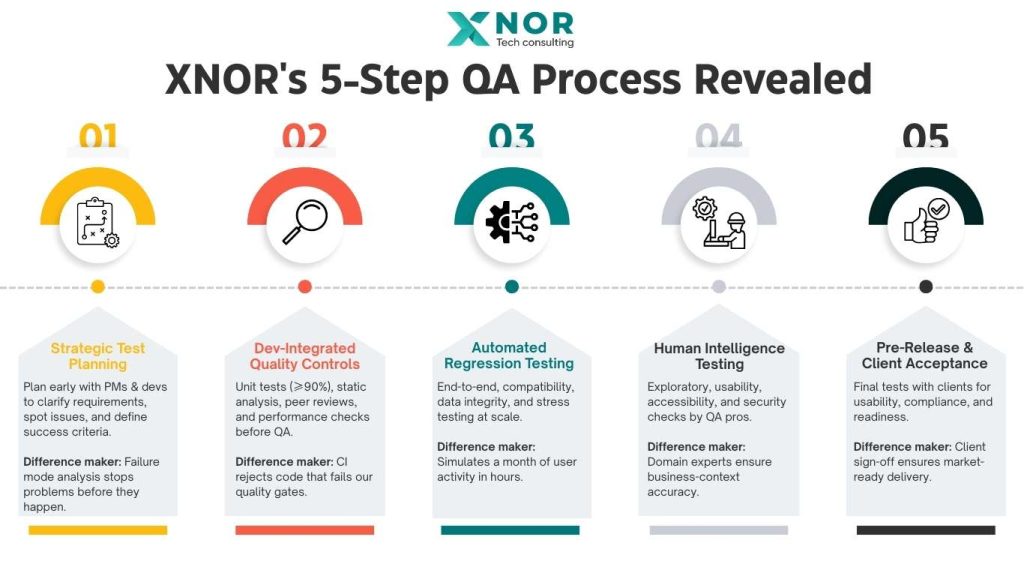Discover the 5-step QA process behind XNOR’s reliable software testing strategies. Go beyond the buzzwords and see how quality assurance creates real product stability.
Why Most QA Processes Fail (And How We’re Different)
When your software fails, your brand takes the hit.
In a world where a 2-second delay can mean losing a customer, quality assurance is no longer a back-office function. It’s the difference between trust and churn, adoption and abandonment.
How do we accomplish this? Through a meticulously refined QA process that most companies simply don’t have the discipline to implement.
This article pulls back the curtain on our proprietary 5-step quality assurance testing methodology—the exact system we use to create software products that consistently exceed reliability expectations. Whether you’re evaluating XNOR Group as a potential partner or seeking to improve your own software testing strategies, you’ll find actionable insights that go far beyond the typical “test more thoroughly” advice.

The Hidden Cost of Inadequate QA
Before examining our solution, let’s understand what’s at stake. The financial impact of inadequate software testing is staggering — as we’ve explored in QA in Software Development: The Silent Killers of Your App, skipping or underestimating QA can quietly destroy your product’s performance and reputation.
- According to the Consortium for IT Software Quality (CISQ), poor software quality represents a significant drain on organizational resources, with billions lost annually due to operational failures, cybersecurity breaches, and legacy system maintenance
- Industry research consistently shows that IT system downtime can cost organizations thousands of dollars per minute, with critical business applications seeing even higher impact rates. (Gartner data, curated by The 20 MSP)
- The Standish Group’s widely-cited CHAOS studies reveal that a significant majority of software projects either fail to meet their original scope, timeline, and budget requirements, or are cancelled entirely before completion
- Software engineering research has long established that defect remediation costs increase exponentially throughout the development lifecycle – what costs $1 to fix during requirements analysis can cost $100 or more to address in production (NASA Johnson Space Center, Error Cost Escalation Study)
These industry realities underscore why organizations increasingly view robust quality assurance not as an optional overhead, but as essential business protection.
At XNOR Group, we’ve developed our QA process not just as a technical necessity but as a business strategy that creates tangible competitive advantages for our clients.
The XNOR Group Difference: Our QA Process Philosophy
Our approach to software testing and quality assurance isn’t based on following a rigid checklist—it’s built on a foundation of core principles:
- Prevention over detection: We focus on preventing defects rather than just finding them
- Shared responsibility: Quality is everyone’s job, not just the QA team’s
- Early involvement: Our QA process begins before the first line of code is written
- Continuous validation: Testing happens throughout development, not just at the end
- User-centric focus: We test for real-world usage, not just technical specifications
This philosophy shapes our 5-step standardized QA process that consistently produces stable, reliable software products.
XNOR Group’s 5-Step QA Process Revealed

Step 1: Strategic QA Process Planning & Requirements Analysis
Unlike conventional approaches that rush into coding, we begin with meticulous planning. Our QA team works alongside product managers and developers from day one to:
- Analyze functional and non-functional requirements through a testing lens
- Identify ambiguities and potential issues before development begins
- Create comprehensive test scenarios based on user stories
- Establish clear success criteria for every feature
- Define testing environments that mirror real-world conditions
The difference maker: Our requirements analysis includes a unique “failure mode analysis” where we identify how each feature could potentially fail and build specific tests to prevent those scenarios.
Step 2: Developer-Integrated Quality Assurance Process
Quality at XNOR Group starts with our developers. Before code reaches formal QA, it undergoes:
- Comprehensive unit testing with minimum 90% code coverage
- Automated static code analysis to catch potential issues
- Peer code reviews with standardized quality checklists
- Integration testing to verify component interactions
- Performance benchmarking against established thresholds
The difference maker: Our continuous integration system automatically rejects code that doesn’t meet predefined quality metrics, making quality non-negotiable rather than aspirational.
Step 3: Automated Testing Process & Functional Validation
Once individual components pass initial quality gates, our automated testing framework takes over:
- End-to-end testing of complete user workflows
- Cross-platform compatibility validation
- Data integrity and boundary condition testing
- Stress testing under various load conditions
- Automated visual regression testing
The difference maker: Our proprietary test orchestration platform can simulate a month’s worth of user activities in just hours, identifying issues that would take weeks to discover in traditional QA processes.
Step 4: Human Intelligence QA Process
While automation is powerful, nothing replaces human intuition and creativity in testing. Our specialized QA professionals perform:
- Exploratory testing to find edge cases computers miss
- Usability evaluation from the end-user perspective
- Accessibility compliance verification
- Security vulnerability assessment
- Localization and internationalization testing
The difference maker: Our QA team includes domain experts in our clients’ industries who understand not just how the software should work technically, but how it needs to perform in specific business contexts.
Step 5: Pre-Release QA Process & Customer Acceptance
While automation is powerful, nothing replaces human intuition and creativity in testing. Our specialized QA professionals perform:
- Exploratory testing to find edge cases computers miss
- Usability evaluation from the end-user perspective
- Accessibility compliance verification
- Security vulnerability assessment
- Localization and internationalization testing
The difference maker: Our QA team includes domain experts in our clients’ industries who understand not just how the software should work technically, but how it needs to perform in specific business contexts.
The Business Impact: From QA Process to Customer Trust
XNOR Group’s standardized QA process delivers more than just stable software—it creates measurable business advantages:
| Benefit | Business Impact |
| Fewer bugs | Less churn, fewer refunds |
| Faster releases | Shorter time to market |
| Lower costs | Catch defects earlier, fix faster |
| Better user trust | Stronger retention, better reviews |
Our Toolkit: QA Tools We Use Tools
We tailor our QA toolkit to your project’s complexity and industry:
| Function | Tools |
| Test Management | TestRail, Zephyr |
| Automation | Selenium, Cypress, Playwright |
| API Testing | Postman, REST Assured |
| Performance | JMeter, Gatling |
| CI/CD | Jenkins, GitHub Actions |
This modularity lets us deliver enterprise-grade testing at startup speed.
Common Mistakes QA Helps You Avoid
Without a QA partner like XNOR Group, you might fall into traps such as:
- Testing too late (post-launch surprises)
- Ignoring edge cases and error flows
- Lacking traceability between tests and business logic
- Over-relying on manual QA without scaling
As evidence, major research firms have consistently found that organizations with accurate resource forecasting deliver projects more frequently on time and within budget.
Final Thoughts

QA is more than just catching bugs. It’s a mindset, a process, and a key to growth.
At XNOR Group, we bring clarity, control, and confidence to every project through a process that evolves with your needs. Whether you’re shipping your first MVP or managing complex enterprise software, we’re your partner in building quality that lasts.



